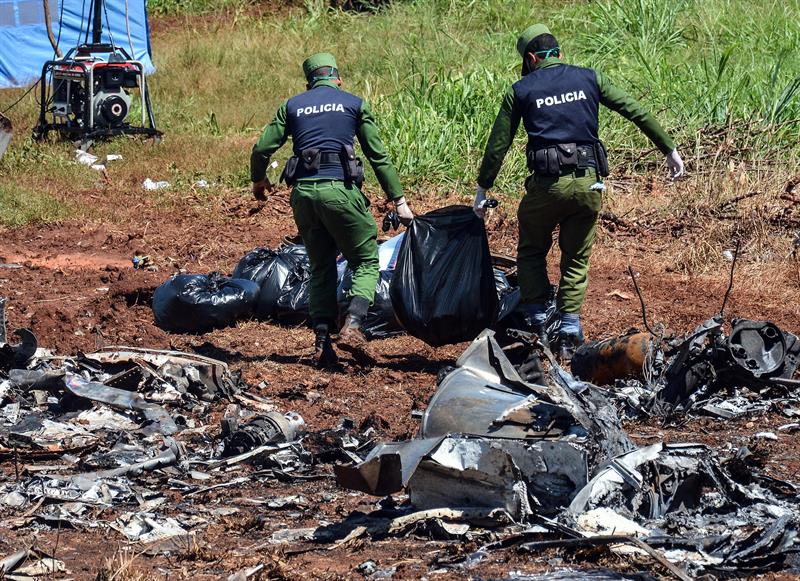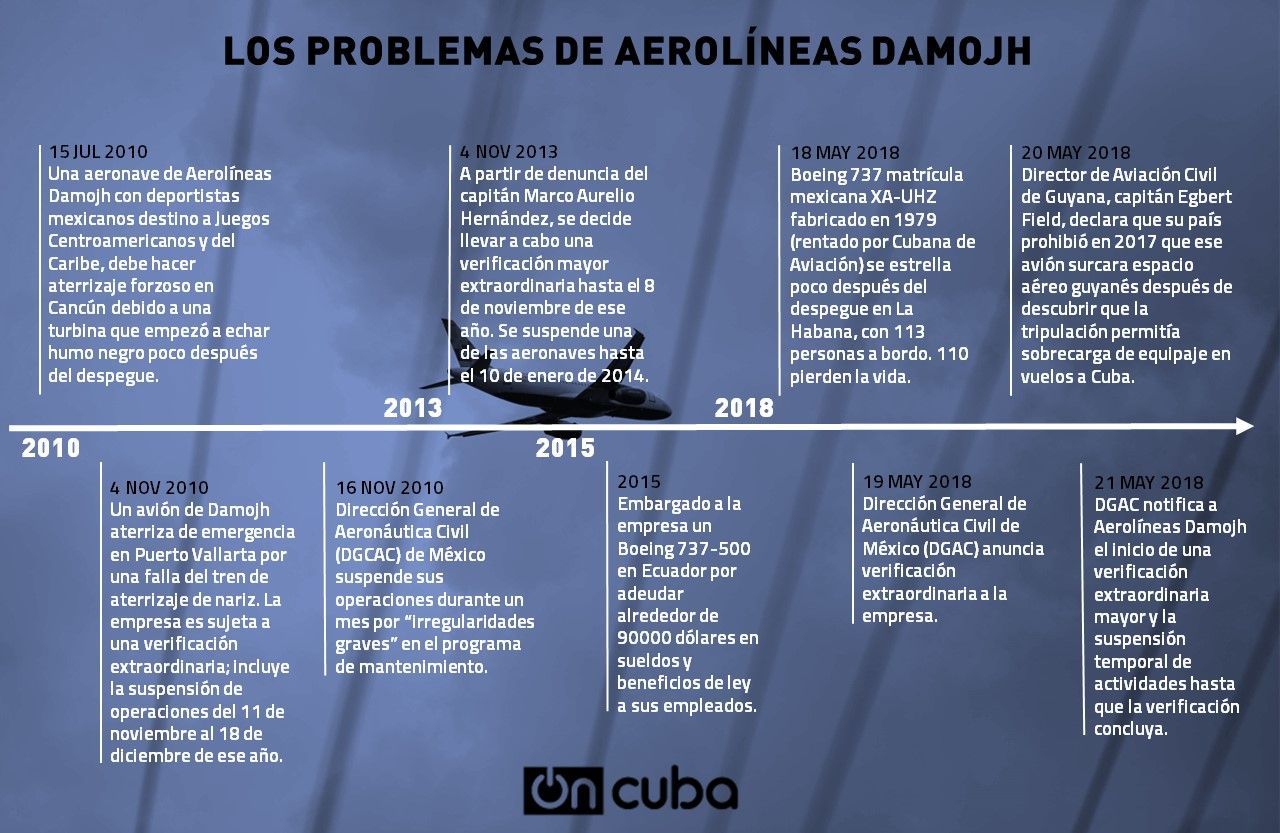Twelve months ago, the tragedy shook Cuba. The crash of a Boeing 737 rented by Cubana de Aviación, just minutes after its departure from the Havana airport on May 18, 2018, shocked the island and beyond.
Flight DMJ 0972, of the Mexican airline Global Air, was traveling to Holguin with 113 persons on board, a dozen of them foreigners, including the crew. Only three Cuban women arrived alive to the hospital, but two died a few days later.
Only Mailén Díaz Almaguer managed to survive, after a long and tense process of recovery, although with serious physical and psychological consequences.
A Cuban governmental commission, with the collaboration of European, U.S. and Mexican specialists, was in charge of investigating the events.
On Thursday 16 it was announced in a brief note that the investigation had concluded that human errors were “the most likely cause” of the accident. Many voices called for greater precision and transparency in the conclusions, and that the actions be informed to compensate the families of the victims and prevent disasters like this in the future.
OnCuba offers a chronology of the main events related to the tragedy.
May 18, 2018: A Boeing 737 of the Mexican company Global Air, also known as Damojh Airlines, crashes at 12:08 p.m., shortly after leaving Havana’s José Martí airport bound for the city of Holguín. Only four people, of the 113 who traveled on the plane, are found alive, but one dies on the way to the hospital. The other three, women of Cuban nationality, arrive in critical condition and start being treated. Cuban authorities decree two days of mourning from dawn on May 19 until midnight May 20.
May 19, 2018: Relatives of the victims arrive in Havana from Holguín and other Cuban provinces. The first deceased in the accident were identified, among them the five minors traveling on the plane. Cuban Deputy Minister of Health Alfredo Gonzalez reports that “it will take days and even weeks” to identify all the victims. The finding of one of the two black boxes of the crashed plane is announced. The General Directorate of Civil Aeronautics (DGAC) of Mexico announces an audit to the company Global Air “as part of an extraordinary verification” after the accident.
May 19, 2018: Minister of Transportation Adel Yzquierdo tells the press that the plane had all its documentation in order and that Cubana had begun to rent it less than a month ago.
May 19, 2018: The Mexican daily Milenio reported that the former captain of Damojh Airlines, Marco Aurelio Hernández, who piloted more than once the plane that crashed in Havana, denounced that on several occasions he had flown airplanes with flat tires, flying through South America without radar, that engines failed on some flights and mechanics lacked spare parts to repair the aircraft.
May 20, 2018: Irregularities are reported in previous Global Air operations. The director of Guyana’s Civil Aviation declares that in 2017 his country banned the plane that crashed in Havana to fly over Guyanese airspace after discovering that the crew allowed overloading of luggage on flights to Cuba.
*CAPTION
DAMOJH AIRLINES’ PROBLEMS
JULY 15, 2010
A Damojh Airlines aircraft with Mexican athletes on board to attend the Central American and Caribbean Games, has to make a forced landing in Cancun due to a turbine that started to issue black smoke a short time after takeoff.
NOV 4, 2013
Based on a report by Captain Marco Aurelio Hernández, it is decided to carry out a major extraordinary verification until November 8 of that year. One of the aircraft is suspended until January 10, 2014.
MAY 18, 2018
The Boeing 737 with Mexican registration number XA-UHZ manufactured in 1979 (rented by Cubana de Aviación) crashes shortly after taking off from Havana, with 113 persons on board. 110 of them die.
MAY 20, 2018
Director of Guyana’s Civil Aviation, Captain Egbert Field, says that in 2017 his country banned that plane from flying over Guyanese airspace after discovering that the crew allowed overloading of luggage on flights to Cuba.
NOV 4, 2010
A Damojh plane makes an emergency landing in Puerto Vallarte due to a failure in the front nose landing gear. The company is subject to an extraordinary verification; it includes the suspension of operations from November 11 to December 18 of that year.
NOV 16, 2010
The General Directorate of Civil Aeronautics (DGCAC) of Mexico suspends its operations for a month due to “serious irregularities” in the maintenance program.
2015
A Boeing 737-500 is impounded from the company in Ecuador for owing around 90,000 dollars in wages and legal benefits to its employees.
MAY 19, 2018
The General Directorate of Civil Aeronautics (DGCAC) of Mexico announces an extraordinary verification of the company.
MAY 20, 2018
DGCAC notifies Damojh Airlines the start of a major extraordinary verification and the temporary suspension of activities until the verification concludes.
——————————————-
May 20, 2018: Ovidio Martínez López, a Cubana de Aviación pilot for more than 40 years, wrote on Facebook that a plane rented from the same Mexican company briefly disappeared from the radar in 2010 and 2011 when it was flying over the city of Santa Clara, which provoked an immediate reaction from the air authorities. As a result, the captain and co-pilot were suspended. According to Martínez, the air safety authorities recommended Cubana stop renting planes and crew from Damojh.
May 21, 2018: 23-year-old Grettel Landrove dies. She is one of the three survivors of the air accident admitted to the Calixto García Hospital in Havana “in extreme critical condition, which was not possible to reverse.” Mexico’s DGAC temporarily suspends Global Air flights, as part of an investigation into what happened. It confirms two previous suspensions in 2010 and 2013, reported in previous press reports.
May 23, 2018: The Mexican newspaper El Universal reports that Global Air is prevented from operating in the United States for not complying “with the maintenance requirements” and for the age of its Boeing aircraft. In addition, it affirms that the last maintenance to the airplane that crashed in Havana was carried out in November of 2017 and speaks of “probable cannibalism of parts” to pass the official verifications.
May 24, 2018: The newspaper Milenio interviews Myrna Diaz, the company’s chief flight attendant between 2013 and 2016. The former employee refers to sustained problems with the aircraft’s spare parts “and even so they passed the inspections of the Ministry of Communication and Transportation (SCT).” According to her testimony, the spare parts that were requested to repair the aircraft did not arrive.
May 25, 2018: Emiley Sanchez, 40, dies. She is one of the two women who remained alive after the plane crash, who suffered a “progressive deterioration” and “the appearance of complications.” They find the second black box of the crashed plane, the one in charge of recording the technical parameters of the flight, according to Armando Daniel López, president of the Cuban Institute of Civil Aeronautics. Regarding the moment in which the conclusions of the investigation could be known, López explains that the process may still “take months or even a year.”
May 27, 2018: After eight days of work, the “absolute” identification of all the victims of the disaster concludes, according to Dr. Sergio Rabell, director of the Institute of Legal Medicine. It is announced that the remains of the last persons identified would leave the next day to their places of origin with their relatives, as had been done with those previously identified.

June 6, 2018: Cuban Minister of Transportation Adel Yzquierdo reports that the two black boxes of the Boeing 737 that crashed in Havana are being investigated in the United States. He confirms that the results of the investigation “may take months.” The medical team that attends to Mailén Díaz Almaguer reports that the only survivor of the air disaster is breathing on her own and her prognosis is “towards improvement,” although she remains classified as “very serious.”
June 12, 2018: Cubana de Aviación officially announces adjustments and cancellations of its domestic flights due to the lack of “the necessary aircraft to cover all the flights.” Although the company does not link the announcement with the plane crash of the previous month, experts consider it a consequence of this and the investigation process.
June 16, 2018: After a relapse days ago that compromised her life, Mailén Díaz Almaguer responds to antibiotic treatment and receives physical therapy and basic rehabilitation, according to part of the medical team. Her status goes from “critical” to “very serious.”
July 16, 2018: The Mexican airline Global Air, owner of the aircraft that crashed in Havana, affirms that the accident was due to a “human failure” of the pilots, who took off with “a very steep angle of ascent.” In addition, it describes as “illegal” the suspension of the activities of the company by the Mexican authorities, motivated in its opinion by the “incompetence and bad faith” of four officials and two former workers.

July 17, 2018: The Cuban commission investigating the plane crash and the General Directorate of Civil Aeronautics of Mexico dismiss the conclusions released the previous day by Global Air, which attributed the disaster to a “human failure.” Both parties consider it as “premature” and assure that the investigation requires the analysis of multiple factors and has not concluded.
August 19, 2018: The Cuban press provides detailed information on the state of health and medical treatment of Mailén Díaz Almaguer. It confirmed her transfer weeks ago from the Calixto García Hospital, where she spent about 70 days, to the Hermanos Ameijeiras to “continue her recovery.” It explains that as a consequence of the accident, the young woman became paraplegic and has undergone a “non-linear” evolution, with “constant dangers to her life” and “opportunistic diseases,” as well as several surgeries, including the amputation of her left leg.
September 6, 2018: The U.S. newspaper El Nuevo Herald reports on the filing in a court in Chicago of the first lawsuits related to the plane crash in Havana. The lawsuits were filed on behalf of the families of three of the deceased passengers, against the company Global Air, which they accuse of being “negligent in the training of their pilots,” which in the criteria of the plaintiffs caused the death of their relatives.
September 18, 2018: The president of the Cuban Institute of Civil Aeronautics, Armando Daniel López, explains that the information of the black boxes of the crashed plane has been recovered “almost in its entirety,” given that “the strong impact suffered by the aircraft did not damage the data” of both boxes. He affirms that “we are working intensely” to achieve a conclusive result, adjusted to international protocols and that they are moving to a phase in which “every detail is analyzed to say exactly if it was a human error or a technical failure.”

October 18, 2018: The Mexican daily Reforma reports that the Mexican company Global Air was fined by the General Directorate of Civil Aeronautics (DGAC) of Mexico for “deficiencies in its procedures.” The DGAC explained that “administrative failures” had been detected in the company after an audit conducted after the plane crash in Havana, for which a fine of 1.7 million Mexican pesos was imposed, just over 90,000 dollars according to the current exchange rate.
October 25, 2018: Cubana de Aviación announces that three days later it would restore several national routes that had been canceled or their frequencies reduced after the plane crash in Havana. In addition, it assures that “later” it will inform about the gradual reestablishment of other flights, “according to the normalization of the conditions in each destination.”
December 16, 2018: Mailén Díaz Almaguer thanks doctors and other people on Facebook for the support received after the plane crash from which she was the only survivor and affirms that every day she is better. These are the first public demonstrations of the young woman, who suffered serious injuries in the accident and a week later would turn 20 in the hospital.
March 14, 2019: The government commission in charge of investigating the plane crash in Havana announces the end of the investigation, with the conclusion of the modeling of the flight profile, and advances that it is preparing the final report on the disaster. The analysis of the two black boxes of the aircraft made it possible “to determine with accuracy elements such as speed, height, turns, power of engines and possible technical failures,” which will allow to issue a final decision, says Armando Daniel López, president of the Cuban Institute of Civil Aeronautics, cited by Cuban television.
March 20, 2019: The first photos were published of Mailén Díaz Almaguer outside a hospital institution, from which she left for a few hours to meet with her family. The images, published on Facebook by the survivor’s sister, show her with good appearance after the complicated process of recovering from the serious injuries she suffered in the accident.

May 16, 2019: The Cuban Institute of Civil Aeronautics announces that “the most probable cause of the accident were the actions of the crew and their errors in the calculations of weight and balance, which led to the loss of control and collapse of the aircraft during the takeoff stage.” In a brief and controversial statement, the institution affirms that the Investigating Commission reached this conclusion after analyzing the data provided by the black boxes and the result of the analysis of the technical parameters of the flight. In addition, it acknowledged the participation in the research of specialists from Cuba, Mexico and the United States. The final report on the accident is not available on the Boeing page, nor has it been published by the Cuban authorities.











